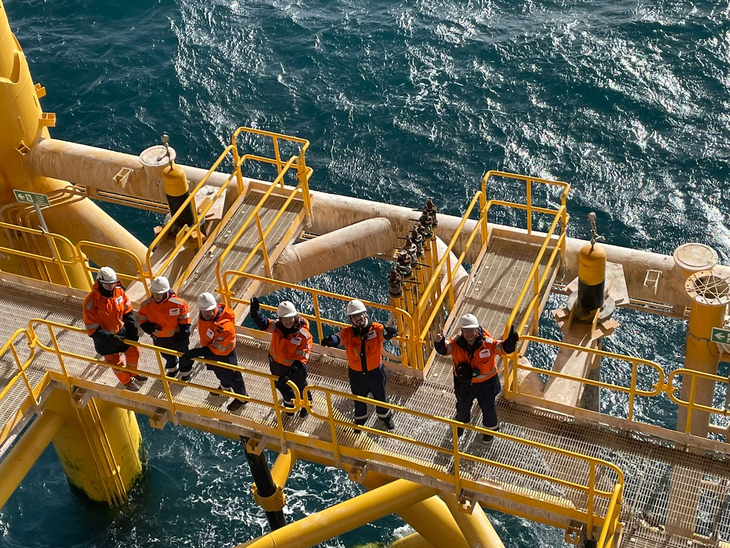Days before gas production begins and after four years of studies, construction and installation, Energy Report landed on the Phoenix and toured the drilling rig and 4,800-ton platform, installed about 60 kilometers off the coast of Land of Firewhere many say the “End of the World”There, 200 km from the Falkland Islands and about 30 minutes by helicopter from the city of Río Grande, some 140 people work every day surrounded by the imposing Argentine Sea, enduring the harshness of the Patagonian wind, the low temperatures, the intense snowfalls, to produce the world’s southernmost offshore gas.
Fenix offshore gas plan.jpg
How to get to the offshore platform
To reach the offshore platform, a helicopter travels for almost half an hour, depending on whether the wind is blowing in your favour or against you. The aircraft travels at a speed of between 250 and 300 kilometres at the moment, at an altitude of 1,000 feet, about 300 metres above sea level. As in all operations of this type, safety comes first.
That’s why, All visitors used waterproof survival suits that prevent contact with water, life jackets for flotation and personal oxygen equipment.. Before leaving and upon arrival at the platform, security officials provided precise instructions to avoid incidents and induction videos were shown.
Phoenix offshore project helicopter exit
Once landed on the rig’s helipad, drilling leaders and three “platformers” from TotalEnergies accompanied the journalists throughout the visit. On the platform they work engineers, geologists, builders, mechanical technicians, electromechanical technicians, computer technicians, health and safety experts, maintenance workers, cooks and even a translator. When necessary, they are even hired professional divers to make underwater pipeline connections. They are all of multiple nationalities: Argentine, American, French, Brazilian, Canadian and Romanian, among others.
The delegation that traveled with Energy Report Tierra del Fuego was made up of Joaquin Lo CaneTechnical Director of Operations at Total Austral; Philippe JeannetDrilling and Wells Manager at Total Austral; Marcelo ReignsTierra del Fuego District Manager, Total Austral, and the geologist Claudia BorbollaPublic Affairs Manager at Total Austral and an expert on sustainability issues. However, during the visit, there were talks with at least twenty people with different roles and responsibilities.
image.png

More natural gas for the energy transition: investment of US$700 million
The managers of TotalEnergieswhich in Argentina is presented with the signature Total Australthey told this media during the visit to the platform that with the Phoenix Project The aim is to continue to meet the country’s energy needs, with an eye on using natural gas as the fuel for the energy transition. In fact, Phoenix It is one of the projects with the lowest carbon footprint per m3 of gas, estimated at less than 10 kilograms of CO2 equivalent per barrel of oil.
At the moment, This offshore initiative is the country’s largest private energy investment. Construction and commissioning required a total investment of US$700 million by the three partners. TotalEnergies and Wintershall They each have a 37.5% stake in the CMA-1 concession, while PAE owns the remaining 25%.
Company sources detailed that of the total amount invested, Some US$200 million were allocated to the platform ($96 million to build it at the Rosetti Marino shipyard in the Italian port of Ravenna and $104 million to locate it)another US$220 million was spent on the manufacturing and installation of pipes and tubing, and another US$240 million on drilling.charge of the baptized rig Noble Queen Allenaowned by the American-Dutch company Noble Corp.
image.png

Although the project began to take shape in 2017, it was not until 2022 that it made significant progress, passing all the stages of environmental assessment and public consultation. On this long road, representatives of the French company admitted serious difficulties due to economic regulations in the country, in particular due to the Dollar cap and permits to import essential equipment and goods.
Although the project was not delayed due to the restrictions still in force, the availability of quotas of dollars for imports and the sanction of the Large Investment Incentive Scheme (RIGI) They provided financial relief. One of the most celebrated measures on the platform is the possibility of transferring profits to parent companies. The operator estimates that this mega-investment will be recovered within the next three or four years.
This is how the Fénix offshore platform was installed in the Austral Basin of the Argentine Sea
Phoenix Project offshore platform.mp4
Given the magnitude of the operation, the logistics for the mobilization of the 4,800-ton platform was carried out in two stages: installation of the jacket First of all, and of the topside (top of the platform) secondly, whose transfer was carried out on the ship CY HTV Interocean II.
The covers of the deck of the Phoenix platform They have a total surface area of 2,500 square meters and include five levels: the helipad, the upper deck, the main deck (where the wellheads and the instrument room are located), and the lower or access deck. The design of the platform allows it to be operated from land, without the need for a permanent crew. This means that once the work is finished, the 140 people will return home. In the event of maintenance, a team of experts will fly in directly.
What is offshore well drilling like?
He jackup rig –technical name given to the drilling platform Noble Regina Allen– arrived in the country after a transoceanic transfer of more than 14,000 km from the North Sea in just 35 days, aboard a heavy cargo ship.
“The equipment chosen for drilling is industry-leading and is specially prepared to operate in complex weather conditions,” they stressed from TotalEnergiesThis rig has a large deck of 8,570 m2, a loading capacity of 3,500 tons and a drilling depth of 35,000 feet, more than 10,600 meters.
Then progress was made with the laying of the submarine pipeline, which connects the new platform to Vega PleiadesThis pipeline was laid using the Castorone, a 323-metre-long naval vessel considered one of the largest in the world and specially prepared for this type of operation.
Drilling experts commented on details of the ongoing activity. In total, four wells will be drilled: three for gas production and a fourth for alternative maneuvers, if necessary. The three drilled wells navigate the gas reservoir (considered a “jewel” of the Austral Basin) of horizontal wayreaching almost 2,500 meters final depth. If measured vertically, the drilling depth was almost 1,100 metres. The equipment and wellheads are monstrous.
image.png

All activities offshore of the project are developed simultaneously with the production operations -already in progress- that Total Austral has been going on for decades in the Southern Marine Basin.
The company’s first offshore activity in Tierra del Fuego was in 1978. Five years later, after drilling 45 wells, the first reservoirs were found. The first one was put into production only in 1989: Hydrawhich is now in sharp decline.
Phoenix offshore wells project
Hydra was followed Kaus, Argo, Carina, Aries and Vega Pleiades. All these deposits were identified with names of stars and constellations. To date, more than 120 wells have been drilled, including exploratory, complementary and production wells.
At the moment TotalEnergies The Neuquina and Austral basins together produce 25% of Argentina’s total gas production. The Fin de Mundo basin produces about 17 million cubic meters per day, or 13%. With Fénix, the French multi-energy company will operate 33% of all gas consumed in the country.
Phoenix offshore platform project

To start up the Fénix platform, some 36.5 kilometres of underwater pipelines were laid. This is how the platform will be in the Argentine Sea once the drilling rig finishes its work.
Source: Ambito




